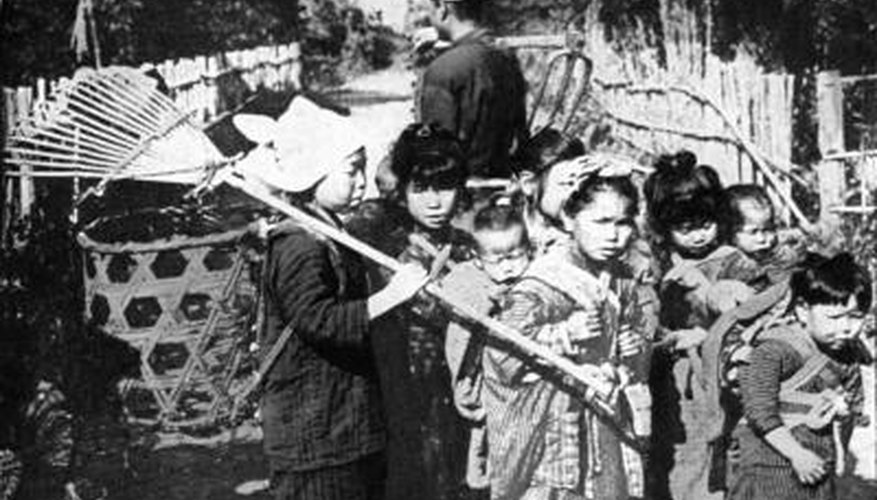At the beginning of the Industrial Revolution, few laws existed to protect children from the harsh, and sometimes deadly, working conditions. As factories spread, the owners of factories, mills and mines needed agile employees who were too young and uneducated to complain about wages and the unfair treatment they often would endure at the hands of shop owners, managers and supervisors. Children, then, were the ideal type of employee. The kinds of jobs they often performed were dangerous and the work hours were gruelling.
Outdoor Jobs
Many children who lived in this era worked outdoors. According to Nettlesworth Primary School, some found employment as street cleaners, while others were street hawkers. The cleaners would sweep the muddy roads, cleaning horse manure and mud to make room for pedestrians and wagon drivers who would walk or ride through the town. The street sellers sold products, such as flowers, lace and muffins throughout the town. Yet other children found work in the countryside. For example, farmers would hire them as bird scarers, whose job it was to chase birds away from crops, protecting the farmers' livelihoods.
- Many children who lived in this era worked outdoors.
- According to Nettlesworth Primary School, some found employment as street cleaners, while others were street hawkers.
Factory Work
Many children worked long and gruelling hours in factories. They often toiled for cruel owners, managers and overseers. The conditions were not safe. One job took place in a match factory. A match dipper would be a child whose job it was to dip matches into an element called phosphorous, which is deadly if a person inhales too much of it into his lungs. Indeed, this chemical caused the children's teeth to rot out and some even died from inhaling the phosphorous fumes. Another factory job involved work at a cotton mill. Mill owners took in orphans and worked them cruelly hard. There was little or no time for exercise, play or fresh air. Mill owners worked them even on Sundays. Time for worship did not exist as management expected them to spend the day cleaning the machinery. Some of the children incurred serious injury as they fell asleep and into the machines. Others incurred scalping as the machine parts caught their hair, ripping it off their heads.
- Many children worked long and gruelling hours in factories.
- Indeed, this chemical caused the children's teeth to rot out and some even died from inhaling the phosphorous fumes.
Coal Mines
Children found employment in the coal mines as trappers, individuals hired to open a trap door by pulling on a string when they saw the coal carts coming. Older kids worked as coal bearers, carrying large baskets of coal on their backs. Later in life -- if they lived that long -- they suffered from a variety of lung ailments, even cancer. There were no workplace safety laws in place.
- Children found employment in the coal mines as trappers, individuals hired to open a trap door by pulling on a string when they saw the coal carts coming.
Residential
Although the British government outlawed the use of boys as chimney sweeps in 1832, owners of large houses continued to employ them. The typical sweep began his career at between five and 10 years of age. As a result, these children, when they first started work, suffered many cuts and bruises. However, the more they worked, the tougher their skin became to it, and the cuts would decrease in frequency. However, chimney sweeping exposed these little ones to inhalation of soot and other materials that were not healthful for their lungs.
- Although the British government outlawed the use of boys as chimney sweeps in 1832, owners of large houses continued to employ them.
- As a result, these children, when they first started work, suffered many cuts and bruises.
